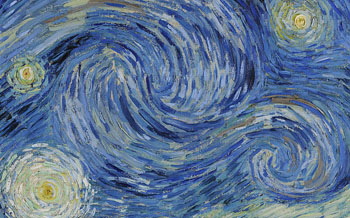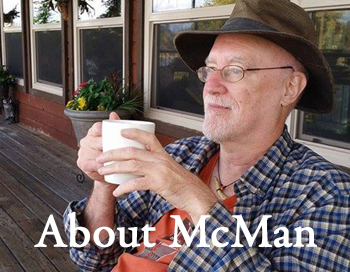
Behavior
 MADLY CREATIVE
MADLY CREATIVE

We may be wildly talented, but there is a catch.
by John McManamy

We may be wildly talented, but there is a catch.
by John McManamy
FROM A POEM by William Blake:
To see a world in a grain of sand/ and a heaven in a wild flower,
hold infinity in the palm of your hand/and eternity in an hour.
Nancy Andreasen has a rare window into the study of creativity. In the early sixties, she obtained a doctorate in literature from Oxford and joined the faculty at the University of Iowa to teach Renaissance literature. Soon after publishing a book about the poet John Donne, she entered the university’s medical school and became drawn to psychiatry and neuroscience.
In the early 1970s, she joined the university’s psychiatry department. There, she was told by the department’s chair that her PhD in literature didn’t mean shit and wouldn’t count favorably toward her promotion. A quarter century later, in recognition of her pioneering research into schizophrenia and neuroimaging, she would be awarded the National Medal of Science by President Clinton. But first she had to prove her boss wrong.
Thanks to her time in the English Department, Dr Andreasen was able to recruit study subjects from the university’s renowned Writer’s Workshop. This included Kurt Vonnegut, who was a faculty member there during the sixties. At the time, she was exploring the anecdotal link between creativity and mental illness, and Kurt afforded an excellent case study.
Kurt battled with depression off and on. His mother committed suicide. His son, Mark, who became a successful physician and author, was originally diagnosed with schizophrenia but may actually have bipolar disorder.
Creativity also ran in the Vonnegut family. Kurt’s father and grandfather were architects, his brother a chemist and inventor, his sister a sculptor, son Mark a writer, and his two daughters visual artists.
When Dr Andreasen set out to do her interviews, she expected to find reasonably well-adjusted individuals who happened to have schizophrenia in their families. For instance, an article Dr Andreasen published around that time reads: “James Joyce. Portrait of an Artist as a Schizoid.” Joyce may have been a bit weird, but his daughter spent her life as a psychiatric resident.
But instead of finding her schizophrenia connection, she told an overflowing room at the 2007 American Psychiatric Association’s annual meeting in San Diego, she was "absolutely astounded" to encounter 80 percent of her subjects with some form of mood disorder, not to mention increased rates of mood disorder and creativity in their first-degree relatives.
As Dr Andreasen acknowledged: "This is a great example of starting out with the wrong hypothesis and coming up with a completely different answer."
Before we proceed any further, we need to raise the yellow caution flag. Numerous studies link bipolar to creativity, but this same research more convincingly demonstrates that the true beneficiaries are the first degree relatives. Science blogger and researcher Scott Barry Kaufman argues that these relatives - and this includes family members of those with schizophrenia - most likely inherited “a watered-down version of the mental illness,” one that is “conducive to creativity while avoiding the aspects that are debilitating.”
This is pretty much where Dr Andreasen is coming from as well. In her 2005 book, The Creating Brain: The Neuroscience of Genius, she noted that the writers she interviewed indicated that “they were unable to be creative when either depressed or manic.”
Essentially, we’re looking to be functional versions of our normal selves. Our own true normal, not someone else’s, that magic sweet spot north of normal, south of bipolar. We need to come into our power, but we also need to learn how to handle the kryptonite.
SIGN UP FOR MY FREE EMAIL NEWSLETTER
It was only when brain scan technology started to improve in the 1990s that Dr Andreasen considered taking the next step in her creativity research. The problem is you can’t just shove a writer into a clanking MRI machine with a keyboard and wait to see what lights up on the monitor.
As she reported in an article she wrote for The Atlantic in 2014, after years of ruminating on what might be special about the brains of the workshop writers she had studied, she had her eureka moment: “Creative people are better at recognizing relationships, making associations and connections, and seeing things in an original way - seeing things that others cannot see.”
To test for this, she needed to study the regions of the brain that go crazy when you let your thoughts wander. Her prime suspects were the association cortices (frontal, temporal, parietal, occipital). To understand how these work, first we need to recognize that that our sensory inputs are processed by highly specialized brain regions. Other specialized regions pull up memory, parse language, and so on. But none of this information makes sense in isolation, where, say, we have a visual signal walled off from from a word walled off from a memory.
Enter the association cortices, which play a key role in integrating the brain’s disparate sources of information. In nature, Dr Andreasen explained, we have non-linear and dynamic self-organizing systems, where small causes may have large outcomes (think butterfly effect). Birds that take off in flight create a formation, then change places to maintain their formation. Similar dynamics can be found in the ecosystem and in the economy. No one is in charge. The whole is greater than its parts. The parts spontaneously self-organize to create something new.
Letters on a page become words, meaning is attached to them, words become connected to each other and to associated memories, which lead to richer meanings. According to Dr Andreasen, the words may be the same, but the way we make associations is what separates Shakespeare from say a stockbroker.
This time, Dr Andreasen has been recruiting scientists as well as writers and artists. Her prize catch is the film-maker George Lucas, but she also has six Nobelists and a Fields Medal mathematician. As of her 2014 Atlantic article, she had scanned 13 creatives along with 13 control subjects.
You cannot force creativity to happen. But you can design tasks - such as pattern recognition - that challenge the brain to make connections and solve puzzles. According to Dr Andreasen, this is the essence of the creative process. Even observing the brain at rest offers clues.As she had hypothesized, in her creatives the association cortices ran wild. "Initially, it just might be gobbledygook,” she explained. Then something locks together. Gook to gobbledygook to E=MC2. "In a way, the brain disorganizes to self-organize to produce a new idea."
Said Mozart: "Whence and how [ideas] come, I know not; nor can I force them … Nor do I hear in my imagination the parts successively, but I hear them, as it were, all at once.As well as performing brain scans, Dr Andreasen spent three days one-on-one with each of her celebrated creatives. This gave her an insight into their personalities. She noticed that are adventuresome and willing to take risks. Moreover they soldier on in the face of doubt and rejection. Tellingly: “This can lead to psychic pain, which may manifest itself as depression or anxiety, or lead people to attempt to reduce their discomfort by turning to pain relievers such as alcohol.”
But the reward is pure bliss. Good science, said one, “is like having good sex.” Said another: “There is no greater joy that I have in my life than having an idea that’s a good idea.”
Her creatives informed her that their eureka moments come to them only after long periods of preparation and incubation. Typically, they occur during off-duty moments, such as in the shower, when the mind is at rest.
In addition, she observed, creative people tend to be autodidacts, people who prefer to teach themselves rather than be spoon-fed. Many also tend to be polymaths, who excel in more than one field. George Lucas, for instance, received two National Awards, one in the arts, the other in technology.
Okay, I hear you: You’re not Vonnegut, you’re not George Lucas. You didn’t win a Nobel Prize. Not only that, your school newspaper rejected your poem for publication and people paid you good money to stop practicing your clarinet. But here’s the deal: We were all born to be creative. It’s part of our evolutionary toolkit. Any time you string words together into a sentence, for instance, you are engaging in the creative process. Dr Andreasen was very emphatic about this. If you have ever succeeded in talking your way out of a traffic ticket - congratulations, you have passed the basic creativity test.
To that we can add that engaging creatively with the world inside and outside of us is as much a part of the creative process as physically creating a work of art or music or literature. When you appreciate the beauty of a tree in nature, congratulations, you have experienced that tree as no one has ever experienced it before. Not only that, many of us inhabit deep and rich interior worlds that have nothing to do with the ability to express ourselves. Our sense of wonder remains valid, even if words fail us.
Often they do.
See also:
Non-linear Thinking
Intuition and Creativity
Altered States
Revised June 29, 2016
![]() VIDEO
VIDEO
NEW!
Follow me on the road. Check out my New Heart, New Start blog.












